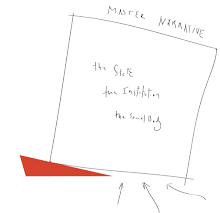Thus, the first manifestation of Indecent Acts was a performance she did in two acts that made referenced to the conceptual practices and social realities of two artists, Guillermo Gomez-Peña and Damila Ayo. The connecting social issues she drew from these artists are "white dominance", institutional racism, assimilation, and inequality. In addition, she added a 5th, mass imprisonment, as another implicit mechanism of oppression in the USA that is indirectly connected to educational discrimination.
The performance didn't mimic the artists nor intended to replicate what they do. The main goal was to connect her own performance in relation to the micro-political issues at her school, and in some respects, in reference to their work. The work functions as an institutional critique, in the form of speech acts, directed towards her Program, “Art, Culture, and Technology - (ACT)”, which she had found has not had any African American students, faculty or staff.
Performance: 02.16.2010 at MIT-E15-001 (Cube)
(There is no video recording of the event, only some photographs of what was left.)

ACT 1: Any African Americans. It begins with a board that has an enlarged paper picture profile of the people who have been in her program plus the phrase on the left top "Indecent Act 1" and right bottom corner "Any African Americans". On each picture she placed a tracing paper creating a patchwork of an even milky veneer. You could see there were pictures of individual members underneath but the tracing paper provided a facade as a metaphor to the systemic social issue. Then she used various water based brown colors that she squeezed on her hands. She used spit to loosen up the color and walked around eliciting for more spit from the audience. The act was both seductive and extremely controversial. Since she didn't have enough spit to spread the color in her hands, she motioned others to contribute, implicitly implicating everyone in the act and suggesting that we are all participating in complacent, unconscious discrimination by not having African Americans in the institution.
Once she had enough diluted paint in her hands she stamped her colored hands on the tracing paper that was covering the photographs of classmates, professors, staff. She did this for each profile.

ACT 2: Blond Hair Extension – This was very simple. She turned the board around that has the phrase "Indecent Act 2" and a “hair extension of blond color” that she attached to her hair. Then, she briefly talked about assimilation, after which, the audience had a chance to respond and have a debate. In general the performance hit home. Some liked it, reaffirming that the issue of lack of representation of a community of color at MIT was not over, while some defended the school by saying that at least it has improved. Few were lightly offended because they felt that she was being aggressive towards the people who are her support system. Others asked why she had not chosen other demographics of people.
The general response was that these issues are important to her because as she is studying mass-imprisonment and inequality in America, of which, an important factor is the level of discrimination against African Americans. Studies demonstrates that their chances to acquiring access to better education and class mobility has been hampered over decades. In turn, this relates to the rest of community of color because we are in a system that is based on a specific, common, socially founded racial dominance - “white dominance”. Of course there many other factors, but this is an important truth to consider when the social elites choose to support by de facto the racially dominant class. Lastly, in the context of art we need to remember that we are working with representations, thus the work is not here to provide the solution but to look at the problem and take action in our daily life. The issue of racial discrimination is an important problem that needs to extend beyond the field of entertainment.
